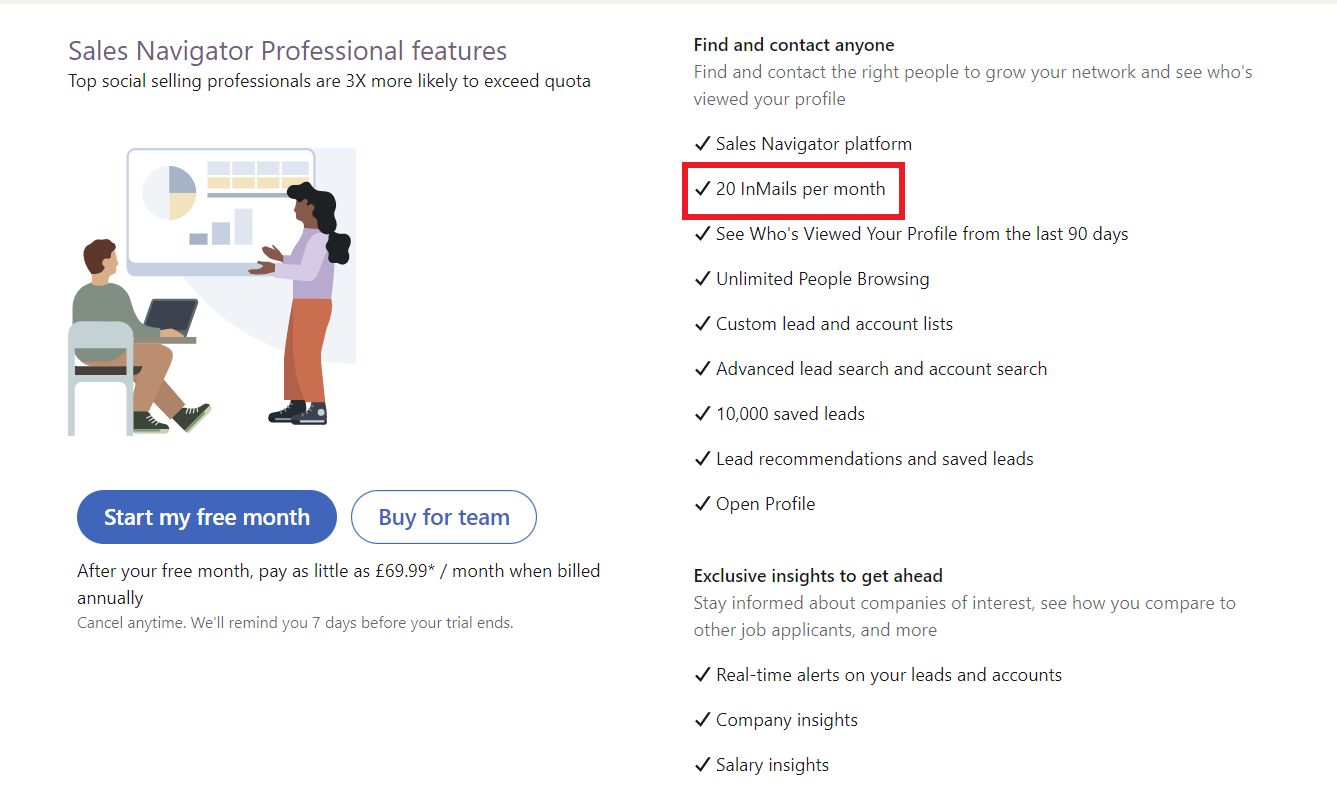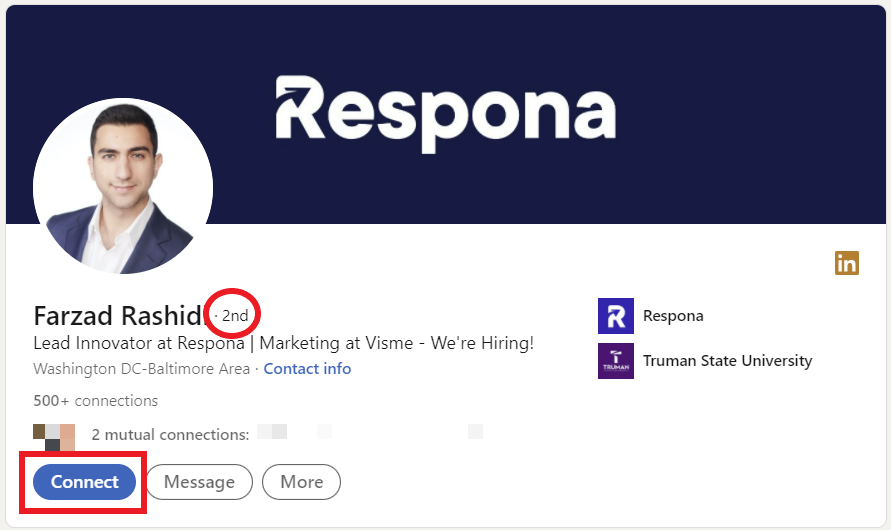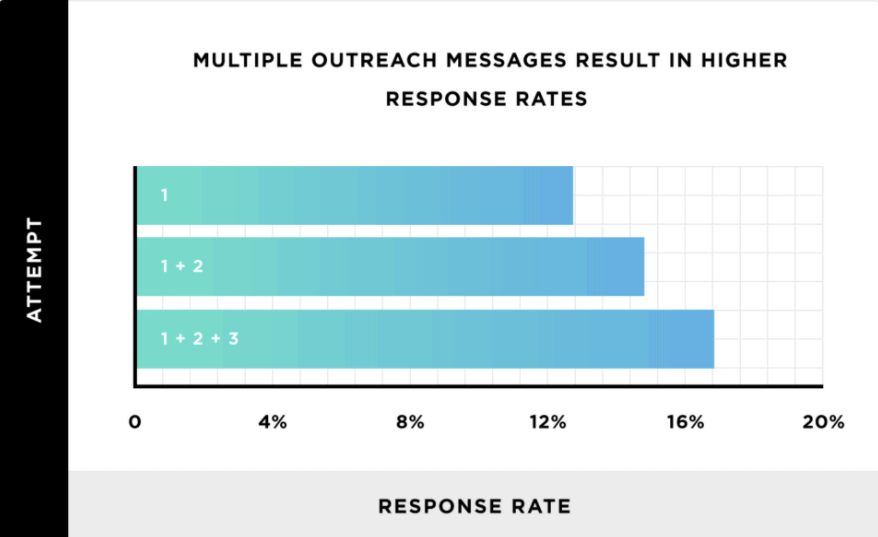Using LinkedIn to reach out to people can be tricky, yet the rewards can be many.
As the social network for professionals, you’ll find people on the platform who are experts, thought leaders, hiring managers, and coaches relevant to nearly any industry you can think of.
Finding a way to reach out to someone on LinkedIn – the right words, how to interact before you contact them, what to do if your outreach goes unanswered – is tough but we’ve got you covered.
In our guide to how to reach out to someone on LinkedIn, we’re going to look at:
- The different outreach methods you can use on LinkedIn
- What not to do when you send a cold LinkedIn message
- Our top tips for LinkedIn outreach
Plus, we’ve got sample messages for a range of use cases when you reach out on LinkedIn and we’ll answer some of your FAQs at the end, too.
Let’s get straight into it.
Link building cheat sheet
The 3 Types of LinkedIn Outreach
Getting your LinkedIn profile noticed starts with making connections and to make valuable connections, you need to reach out to people.
There are different approaches you can take and some will work better for you than others.
What’s important when you’re reaching out on LinkedIn is to learn what’s effective for you, your industry, and your personality – LinkedIn is a social media platform, after all.
Let’s take a deeper look at the three broad types of LinkedIn messages you can use for reaching out to potential contacts.
Type #1: The “As Cold as it Can Get” one
The “as cold as it can get” LinkedIn message is exactly what it says – a message from out of the blue to a person who has no understanding of who you are.
This is only an option for some LinkedIn profiles though.
When you upgrade to a premium LinkedIn account, you get access to InMail which lets you send messages to people that you don’t already have a connection with.

There are different plans you can choose from, our screenshot is of the Sales Navigator Professional package.
Reaching out to someone out of the blue can be daunting, but with the right message – which we’ll look at a little further on – you can create a valuable business connection.
You can use cold outreach for a range of reasons on LinkedIn, such as:
- Before you make a connection
- To make a brand pitch
- To reach out about guest posting on a blog
- To ask for someone’s business email
And plenty more besides.
Type #2: The “I Know You From Somewhere” one
When you’ve already met someone – in real life or virtually at a conference or webinar – you can use this to warm up your approach on LinkedIn.
If you’re working with InMail, you can send your cold message and include a reference to having come across them before, for example, if you’re in the same group for digital marketers on Facebook or were in the same breakout session at a recent networking event.
Bringing up something you have in common with the person you’re cold messaging lets them know that:
- You’ve done your research
- Move in the same circles
- h=Have common professional interests
What about if you don’t have access to InMail?
You can still use LinkedIn to make connections with people with whom you share interests – you can send a message along with your request to connect.
You can send connection requests to any second-degree connection; you’ll see a “2nd” next to their profile and you’ll have the option to connect with them, and to anyone who you’re in the same LinkedIn groups as.

When you click on the Connect button, you’re given an option to add a note to the connection request:

Here, you can add information about why you’re sending the person a request and where you know them from – we’ve got templates for this coming up shortly.
Type #3: The “Common Connection” one
Name dropping a mutual friend or business associate is a great way to let someone know you’re already connected.
It’s an even more personal way to show a potential connection that you’re a valuable contact since someone they know is already a contact!
If you’re going the InMail route with your LinkedIn cold outreach, you can still check your recipient’s profile to see if you have any mutual friends you can talk about.
You can also look on other social networks such as Facebook to see if you have common friends you can refer to.
This is information that’ll help you personalize your initial message on LinkedIn and quickly build some rapport.
When you don’t have premium features on LinkedIn, you can only send a request to a person you have a common connection with.
Since you can have up to 30,000 connections, it can still be helpful to include in your connection request note which of your mutual connections is closest to you or the most valued.
For example, you may have a common connection through an old university friend and through a current work colleague – if you’re connecting for business, it may be better to highlight the colleague over the classmate.
We’ll give you a template for this a little later, but first, we’ve got a list of things to avoid when expanding your professional network on LinkedIn.
What to Avoid When Reaching Out to People on LinkedIn
There’s plenty that you need to do to successfully reach out on LinkedIn, yet these things could all be ruined by a misstep in your contacts, too.
Successfully connecting with a LinkedIn user to expand your visibility or making a pitch in the future means you need to know what to avoid in your outreach – whether through a cold message or through a connection request.
Here are our top four things to avoid when working on your LinkedIn network.
What to Avoid #1: Pitching anything on the connection request message
Your connections on LinkedIn should be genuine – you’re connecting with people for a mutually beneficial purpose, which is usually business networking.
In your first message or your connection request, you should resist the temptation to go in for the pitch, like this person did…

Treat LinkedIn networking as a long game and prioritize meaningful connections over the quick pitch.
When you make a new connection, you should give them a chance to get to know you and the content you put out on your profile as well as interacting with their content by reacting to posts or making an insightful comment.
Once you’ve established a professional relationship, you can consider making a sales pitch, but not straight out the gate.
What to Avoid #2: Pitching anything on the second message
Yes, we think cold outreach on LinkedIn is a really long-term strategy.
Working to form a personal connection means not jumping straight into your pitch even the second time you reach out to them.
Take time to build rapport and let your new connection know that you value them rather than how likely they are to buy your product or service.
Create a strong connection based on mutual trust so that when it is time to make a pitch, you have people willing to listen because they value you as a professional.
What to Avoid #3: Talking about yourself
Connecting with a new person through outreach messages is about them – you’re interested to be part of their network and want to know who they are or what you do.
Therefore, you need to check your ego and not talk about yourself on LinkedIn messaging and connection requests.
Focus on why the person you’re contacting is a person you find interesting or valuable – flattery will get you a lot of places, as long as it’s sincere at the same time.
Tell the person you’re contacting or connecting with:
- How you know them – if you do
- If you’ve met before
- About a recent post they made that resonated with you
- Why you think they would be a valuable connection
Keep the spotlight on them because it’s likely you’ll be asking for something from them in the near future.
Plus, your profile should contain all the information they need to know – we’ll look at this in the next section.
What to Avoid #4: Faking it
Keep your outreach on LinkedIn honest so you don’t get into hot water.
You’re trying to connect with a total stranger or at least someone you barely know, so you want to get off on the right foot and avoid any fake or over-inflated information in your outreach.
Keep things honest, especially if you have mutual connections because too much fluff and exaggeration can be easily uncovered.
That’s what not to do when you try to connect with new opportunities on LinkedIn, here are some tips that should boost your response rates and positive outcomes.
Tips to Follow When Reaching Out to People on LinkedIn
Getting your LinkedIn outreach right is going to boost your lead generation, increase your industry authority, and improve your chances of a career change in the future.
There are some best practices that are specific to LinkedIn and others that you’ll find when you’re reading about how to do cold outreach by email.
We’ve gathered the best tips to help you connect with your target audience on the platform.
Tip #1: Follow your prospect and engage with their content prior to reaching out
On LinkedIn, members can choose to have a Follow or Connect button – you follow someone when you may not have a direct connection but you’re interested in what they have to say and want to see their posts.

Before reaching out to someone you want to talk business with, you can follow them and get to understand what they’re about.
You also have the opportunity to interact with any of their content they’ve chosen to make public.
Use this opportunity to find common ground and offer insight – maybe you’ve had a similar experience to one they’ve shared or can help solve a pain point they post about, a comment with your input will always get noticed.
Tip #2: Do your research
Before approaching anyone with a cold message – or email – you should learn as much as you can about them.
LinkedIn is a great place to learn about someone’s professional interests and background.
Search through LinkedIn members’ profiles and you’ll learn:
- Where they went to school
- What they studied
- Their employment history
- People and companies they’re interested in
You can use this information to find common ground and then insert that into your cold message on LinkedIn’s InMail or add it to your connection request – making a personalized contact that will be much more valued.
Tip #3: Personalize your connection request message
Now you know some useful nuggets of information about your prospective connection, you can send a more personalized message.
There is no data available about how successful a personalized message on LinkedIn will be, but we know that when it comes to emails, personalization works.
According to a study by Backlinko, emails with personalization inside the body text get 20% more replies than a cookie-cutter email.

You can be pretty certain that a LinkedIn message with some personalized elements will stand out from an inbox full of generic contacts.
Tip #4: Follow up – without being annoying
The power of a follow-up email is well known; the same Backlinko study tells us that follow-ups can increase your response rate by up to 65%.

Of course, LinkedIn outreach is different from email or SMS performed using SMS marketing platforms, but gentle persistence does pay off when reaching out to a potential business contact.
It’s important to note that even with InMail, you can’t send a follow-up message until they accept and respond to your first message.
However, if you get a quick response and want to try and open up a dialogue, you can send a follow-up asking specific questions or highlighting a new mutual contact.
Tip #5: Your message should be short and to the point
Although aimed at professionals, LinkedIn is still a social network and as such, you get limited time to catch someone’s attention.
Keep your message clear and concise with no fluff or paragraphs of details – very similar to when you write a cold outreach email or pitch.
Remember that there isn’t an option for a subject line for a LinkedIn message, but you do get a few words as a preview to your message so use them wisely.

Have a powerful opening, explain exactly what you’re asking for or need, then close with a clear call-to-action; you’ll see this pattern in the sample messages we’re looking at in the next section.
Tip #6: Optimize your profile
The last time you received a cold outreach message from someone on LinkedIn, what was the first thing you did?
We’re pretty certain you clicked on the sender’s profile and checked out who they were.
It’s a common action and you need to be prepared for it by optimizing your profile to try to ensure you get a response to your message or connection request.
You need to make sure that:
- You have your company name and job title displayed clearly in your LinkedIn headline
- Your About section is clear about your background, skills, and achievements
- Your employment history is accurate
- You’re actively posting interesting, engaging, and insightful posts
So that anyone who clicks through will be intrigued and want to see your content and engage with your posts in the future.
That’s what you need to do, now let’s check out the message templates for LinkedIn outreach that we have for you.
5 LinkedIn Connection Request Messages to Expand Your Audience
You’ve got the dos and don’ts when it comes to writing cold messages, outreach, and connections requests – now it’s time to see how some messages look in reality.
When you use our LinkedIn sample messages, be sure to fill in the personalization elements.
Wherever you see {braces}, this is a space for you to add information about your or your recipient; personalization will help boost your response rates.
Template #1: Out of the blue connection request
When you’re sending a connection request, always add a short message so they know why you want to connect.
Subject: Subject
Hi {Their name},
{Your name} here, I’m a {your profession} and I’m looking to expand my network to other professionals in the {your industry} industry.
Would love to connect and see your updates.
Thanks!
{Your name]
Use Case: Sending a connection request to a person you don’t know.
Template #2: Connecting after already meeting
After a face-to-face or virtual meeting, it’s the perfect time to send a message on LinkedIn.
Subject: Subject
{Their name},
Was great to meet you at {name of event/meetup/conference}.
{Add relevant sentence about a conversation you had or a comment they made that you appreciated}
We seem to be on the same page and I’d like to add you to my network and hear more of your insights.
Let’s connect!
{Your name}
Use Case: Someone came up on your radar at a professional event and you want to take advantage of the meeting to make a LinkedIn connection.
Template #3: Connecting after watching a webinar
Everyone likes to get a genuine compliment and connect with people who appreciate them, and this template helps you do exactly that.
Subject: Subject
Hi {Their name}!
Wanted to [drop you a message/make a connection] after watching your recent webinar about {summary of webinar}.
I found your ideas really insightful and I’ll definitely be putting your tip about {actionable advice given in webinar} into use this week!
How about we connect and expand our networks?
{Your name}
Use Case: You’ve just watched a webinar and got inspired! You want to learn more from the host and send a message or connection request.
Template #4: Name-dropping a mutual connection
Especially with a big network on LinkedIn, it can be easy to find potential new connections that are already second- or third-degree connections.
However, it’s best to only use a mutual connection’s name in your request if you have a personal connection to them already.
Subject: Subject
Hi {Their name}!
Hope you’re having a great week! I saw your post about {brief summary about a recent post}; it came up on my feed when {Mutual connection name} reacted to it.
It really got me thinking and that’s the type of content I love to see – want to connect so we share insights and business news in the future?
{Your name}
Use Case: You see a person’s post through a mutual connection and you find their content interesting enough to connect with them.
Template #5: Personally connecting after finding them in a group
Groups are getting more important on LinkedIn and they’re a great way to find people with common interests and professional skills.
Be sure to use this template when you know someone is actively engaging in a group you’re both in.
Subject: Subject
Hi {Their name},
I spotted you [comments/post] in the group {group name}.
The content you post in there is really valuable and your contributions really add to the dialog. We share a lot of ideas about {your common industry or niche} and I’d love to connect so I can see more of what you post.
Let’s connect!
{Your name}
Use Case: You want to connect with someone who contributes to a group you’re both in.
Those are all our templates to help you plan out your connection requests on LinkedIn, let’s bring this to a close.
Link building cheat sheet
Now Over to You
That’s everything you need to know about reaching out to people through LinkedIn.
We’ve looked at best practices and things to avoid so you can get your LinkedIn outreach messages on point.
Test out our templates and see how you get on increasing your connections, generating leads, and boosting your engagement.
Want to up your outreach game and bring email into your strategy?
Respona is a tool that’ll level up your outreach through email and even help you find the right contacts on LinkedIn.
Request a demo of our tool and see how it can boost your outreach.
Frequently Asked Questions (FAQs)
Getting to grips with a new social platform is a challenge, so we’ve pulled together questions we hear a lot just for you.
Q1. What is the best way to reach out to someone on LinkedIn?
The best way to reach out to someone on LinkedIn is through sending a connection request with a personalized message explaining why you want to connect. You can also send a cold message directly to someone’s inbox if you’re a premium subscriber.
Q2. Can you contact someone directly on LinkedIn?
You can contact someone directly in their inbox by sending them a private message. You can send a message when you’re already connected or if you’re in the same group as them.
If you’re a premium member, you can also send a limited number of direct messages to people each month.
Q3. Is it weird to reach out to someone on LinkedIn?
It’s not weird to reach out to someone on LinkedIn – it’s a networking platform for business people so it’s expected. Get your outreach right, though.
Make your messages and connections personal and keep it professional.
Q4. What should you write in a LinkedIn connection request?
When you send a LinkedIn connection request, you should write the reason you’re asking to connect and point out mutual connections, groups you have in common, or other personal touches that demonstrate that you’re a stranger trying to connect.
Q5. Should you add a personal note when you connect on LinkedIn?
Yes, you should add a personal note when you connect on LinkedIn. It’ll ensure the person you’re connecting with knows who you are and the reason you want to connect with them.








